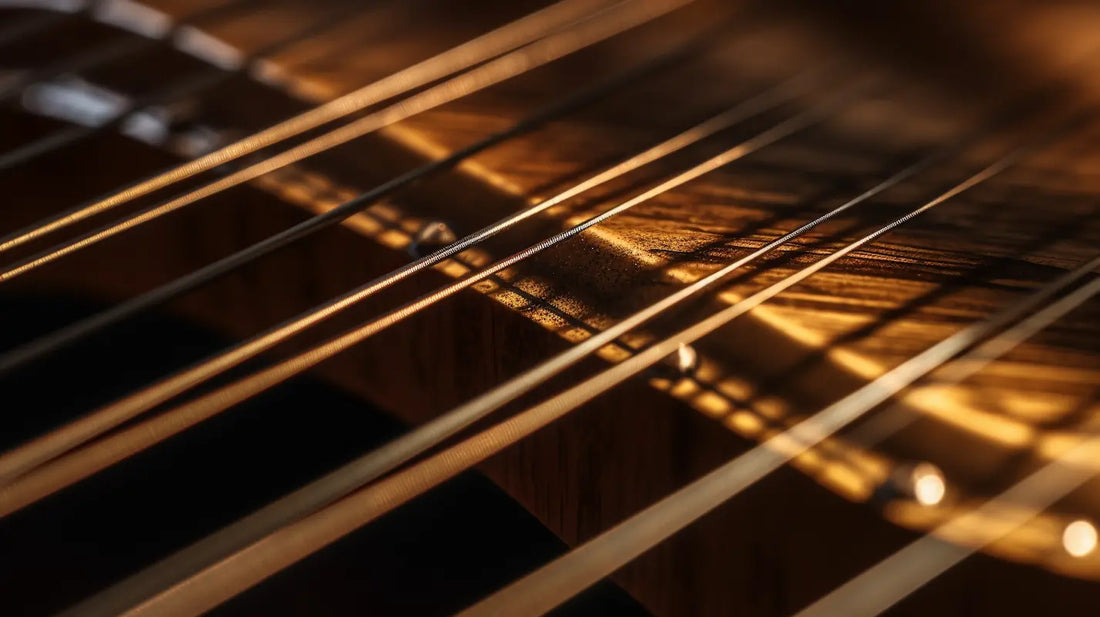The guitar reigns as the world's most enduring and beloved string instrument. The strings of a guitar are paramount in defining its voice. Each one is a strand of potential that, when plucked or strummed, brings forth an array of sounds and tones as diverse as the musicians who play them.
And if you want to know how many strings a guitar has, we need to dig into their role in crafting the tapestry of music that emanates from this iconic instrument.
Guitar
A guitar is a stringed musical instrument, most typically with six strings. These strings are usually made of nylon or steel and tuned to different pitches to create a range of musical sounds. The strings are plucked or strummed to produce melodies and harmonies.
While most guitars have six strings, some guitars have seven, eight, nine, twelve or even more strings. These guitars are often used in specific styles of music, such as jazz, metal, or classical.
Types of Guitars
- Acoustic Guitar
- Electric Guitar
- Classical Guitar
- Bass Guitar
Each type of guitar has its own unique sound and playing style, but they all share the common feature of having strings played to create music.
Understanding the different types of guitars is crucial to grasping the essence of how string numbers and sounds can vary. While guitars generally share similar shapes and functions, their construction and the materials used can greatly affect the number of strings and the resulting sound.

Electric Guitars
Electric guitars are typically built with metal strings, which help produce a magnetic field that pickups can detect. This allows for the amplification of the sound. The solid body construction of an electric guitar often contributes to its ability to sustain notes longer, and its association with genres like rock, metal, and blues is well-noted.
Acoustic Guitars
The acoustic guitar's hollow body design naturally amplifies the vibration of strings. This construction gives it a distinct, rich acoustic sound that resonates with folk, country, and pop genres. Most acoustic guitars have either six strings or 12 strings.
Classical Guitars
Classical guitars are known for their nylon strings, which offer a softer, warmer tone compared to the brighter sound of steel strings. The mellow sound of nylon strings is favored in classical and flamenco music styles.

Bass Guitars
Bass guitars typically have four strings tuned to produce low-end frequency sound. They provide the rhythm and foundation for various musical genres and play a crucial role in the overall harmony of the music.
Different guitar types can offer artists a range of sounds and styles to choose from. The number of strings on a guitar is an important factor that contributes to its unique sound and the music it can create.
Standard Guitar String Number
Most people imagine the prototypical version with six strings when picturing a guitar.
This setup is not merely a matter of tradition; it is a design withstood the test of time for offering a versatile range of notes that suit a broad spectrum of musical styles. Let's explore why the six-string guitar has become such a staple in the music world.
Examine the standard six-string guitar layout
The standard six-string guitar, also known as the Spanish guitar, usually comprises strings tuned to the notes E, A, D, G, B, and E, from the lowest (thickest) string to the highest (thinnest). This tuning has been established as the foundation for a wide range of music due to its ability to produce deep bass lines, rich melodies, and bright chords- all on a single instrument.
Why six strings have become the norm in most musical genres
Six strings have become the norm because they allow guitarists to cover various pitches commonly used in Western music. This versatility makes the six-string guitar an ideal instrument for playing lead lines, rhythm parts, and even bass lines, making it incredibly popular among solo performers and bands.
- The layout accommodates a wide sonic spectrum, catering to lower and higher register frequencies.
- Six strings balance complexity and playability, ensuring musicians can pick up the instrument and start playing without an overwhelming learning curve.
- Many musical genres have wholeheartedly adopted this arrangement, from rock and blues to pop and classical, indicating its universal appeal.
In essence, the six-string guitar's popularity rests in its musical utility and cultural resonance across various genres. When we think of a guitar, we inadvertently conjure an image of an instrument finely tuned to our musical tradition, and that tradition sings with six strings.
Variations in String Numbers
When most people picture a guitar, they imagine the traditional six-string design. But the world of guitars is vastly diverse, with variations designed to cater to different musical styles and player preferences. As we delve into the realm of different guitar types with various string numbers, it becomes evident that each configuration offers a unique sound and playing experience.

Seven-String and Eight-String Guitars
The seven-string guitar adds a lower string, often tuned to B, which extends the instrument's tonal range and allows for deeper bass notes. This addition has become particularly popular in genres like metal and jazz, where a broader sonic palette is desirable.
Similarly, eight-string guitars push these boundaries further, offering an additional low string, typically tuned to F# or E. This extended range can be pivotal for creating complex, layered music that demands a wide array of pitches.
Twelve-String Guitars
If you're seeking a richer, more resonant sound, the twelve-string guitar might be your choice.
Instead of single strings, it features pairs or courses-two strings played together in unison or an octave apart. This pairing creates a chorus-like effect and a fuller sound instantly recognizable in folk, rock, and other forms of popular music.
However, the doubled strings require a more robust construction and can be more challenging to play.
Alternate Tunings
Guitars are versatile not just due to their physical structure but also because they can be tuned in different ways. Alternate tunings significantly transform a guitar's sonic landscape, offering musicians many possibilities. Tuning refers to the specific pitches assigned to each string, setting the basic tonal foundation for playing and composing music.
The Role of Tuning in Stringed Instruments
Stringed instruments like the guitar are designed to resonate at certain frequencies. The tuning process aligns these frequencies to desired musical notes, usually according to a well-recognized system. In standard tuning, the strings from the lowest to highest are typically tuned to E, A, D, G, B, and E, establishing a familiar tonal framework for guitarists. This system provides a musical scale that is logical and user-friendly.
How Alternate Tunings Can Effectively Change the Number of Pitches Available
Alternate tunings offer guitarists an opportunity to experiment with different sounds and techniques. By changing the pitch of one or more strings, players can explore new chord voicings, extended harmonic ranges, and easier access to certain intervals and scales. Some alternate tunings allow for open chords to be played with all open strings, which effectively changes the "landscape" of the guitar fretboard.
- Dropped Tunings: Dropped tunings lower the pitch of the sixth string, enabling power chords to be played with one-finger barre shapes.
- Open Tunings: Tuning the strings to match a specific chord, open tunings allows players to strum the open strings to create a full chord without fingering.
- Modal Tunings: Tunings are designed to facilitate playing in specific musical modes, giving the guitarist new melodic and harmonic options.
Each alternate tuning not only changes the number of available pitches but can also inspire different stylistic choices and songwriting approaches. From the deep, bluesy growl of a slide guitar in open G to the intricate fingerpicking patterns enabled by DADGAD, alternate tunings continue to be a source of creative expansion for guitarists across all genres.
Historical and Traditional Guitars
As we know it, the guitar has been shaped profoundly by its rich history, which has evolved through various cultures and time periods. This evolution has significantly influenced the number of strings commonly found on modern guitars. To understand why most guitars today have six strings, it is essential to delve into the instrument's traditional and historical roots.
Insight into Historical and Traditional Variations
Originally, the guitar's ancestors - such as the lute, vihuela, and earlier the medieval gittern - had a varying number of strings, typically ranging from four to as many as ten or more. The six-string guitar, often credited to Spain in the 16th century, became the standard due to its versatility and richer harmonics. Over the centuries, this format was adopted widely, leading to the six-stringed instrument's dominance.
The Evolution of String Use Across Different Cultures and Time Periods
Guitars and similar stringed instruments have been pivotal in music-making worldwide, and their string arrangements reflect their time's cultural preferences and musical styles. For instance, the Baroque guitar commonly had nine or ten strings in courses of two, while the Renaissance guitar was typically a four-course instrument. Meanwhile, traditional 12-string guitars, which double up each of the six strings to create a chorus-like effect, have roots in Mexican and other folk music traditions.
- European Influence: The introduction of the sixth string in the 1700s was widely accepted in Europe, opening up a broader range of tonal possibilities.
- Middle Eastern Origins: Early instruments in the Middle East were predominantly plucked with a plectrum and typically had fewer strings, which influenced the development of early European stringed instruments.
- African and Asian Contributions: African instruments such as the kora, with up to 21 strings, and traditional Asian instruments like the Chinese guqin, prove that guitars did not develop in isolation but as part of a global evolution of stringed instruments.
Gaining an understanding of the historical and traditional backgrounds of the guitar not only enlightens us about the 'how' behind the number of strings but also enriches our appreciation for the instrument's diverse sonic capabilities that continue to evolve to this day.

The Impact of String Material and Construction on Sound
Guitar strings play a pivotal role in shaping the instrument's tone. Understanding how different string materials influence sound production is crucial for guitarists and enthusiasts. Let's explore the acoustic properties that distinguish metal strings from nylon strings and the impact of string construction on the guitar's voice.
Metal vs. Nylon: A Tonality Contrast
The choice between metal and nylon strings is often determined by the style of music being played and the acoustic qualities desired by the musician. Metal strings, typically made from steel or nickel, produce a bright and articulate tone well-suited to genres such as rock, country, and folk. The crisp sound of metal strings is due to their tendency to vibrate at a higher frequency, offering pronounced harmonics.
In contrast, nylon strings, which are commonly found on classical and flamenco guitars, emit a warmer and mellower sound. Their softer material allows for a more nuanced tonal palette, highlighting the rich overtones. Nylon strings' lower tension also contributes to their distinctive gentle and rounded timbre, favored in classical music and traditional ballads.
Material Science: The Link Between String Materials and Acoustic Quality
The science behind string materials extends far beyond a simple choice between metal and nylon. Alloys and composites used in string construction further refine the quality of sound. For instance, phosphor bronze strings deliver a deep, warm tone with a smooth feel, which is preferred by many acoustic guitarists seeking a more "woody" sound.
Coated strings, another technological advancement in string construction, not only prolong the string's lifespan but also affect tonal brightness and sustain. Similarly, variations in string gauge, or thickness, can influence volume, sustain, and the player's physical comfort. A heavier gauge generally produces a fuller and louder sound with more sustain, while lighter gauges offer ease of playability and a brighter tone.
In summary, the material and construction of guitar strings are fundamental components that shape the instrument's character and playability. Whether it's the twang of a heavy steel string on an electric guitar or the soothing caress of nylon strings on a classical one, the strings' properties are integral to the art of guitar music.
- Metal strings: Bright, articulate, higher tension, suitable for various genres.
- Nylon strings: Warm, mellow, lower tension, favored for classical and flamenco styles.
- Alloys and composites: Contribute unique characteristics to the sound and feel of the strings.
- Coated strings: Alter tone and increase lifespan.
- String gauge: Affects volume, sustain, and playability.
Guitar Genres and String Preferences
Guitars are as varied as the music genres they are used in. Across different styles of music, the number of strings on a guitar can play an essential role in defining the sound and playability that musicians prefer. Different genres often call for different types of guitars, which, in turn, can influence the number of strings a player may choose.
Classical and Flamenco
Classical and flamenco guitarists typically adhere to the traditional six-string nylon-string guitar. This setup allows for expressing intricate melodies and the complex finger-picking techniques that these styles demand.
Rock and Metal
In rock and metal, guitarists often venture beyond the conventional six strings. Seven-string guitars, such as those used by Steve Vai, provide an extended lower range, perfect for heavy riffs and solos. Even eight-string guitars are not unheard of in these genres, with musicians like Tosin Abasi pushing the boundaries of guitar music.
Jazz
Jazz musicians, known for their complex chord structures and improvisational play, tend to stick with six-string guitars. The legendary Wes Montgomery, for example, used a six-string guitar to produce his innovative thumb-picking sound.
Country and Bluegrass
In contrast, country and bluegrass genres have a distinct affection for the bright, twangy sound of a six-string steel-string acoustic guitar. Iconic musicians such as Johnny Cash have immortalized the six-string sound within these genres.
Extended-Range Guitars
Extended-range guitars, which can have seven, eight, or more strings, are becoming increasingly popular in experimental and progressive music genres. These guitars offer a broader sonic palette for creating new and unique sounds.
- Seven-String Guitars: Favored by artists in genres that require a heavy, aggressive tone and additional lower notes.
- Twelve-String Guitars: Common in folk and rock music for their rich, natural chorus effect and fuller sound, as played by the likes of Roger McGuinn of The Byrds and Tom Scholz of BOSTON.
- Extended Range Bass Guitars: Used often in jazz fusion and progressive rock, these may have up to six or more strings to accommodate complex musical arrangements.
Understanding these preferences can help players choose the right number of strings for the music they intend to create or perform. The guitar's adaptability across genres is a testament to its versatility and the infinite creative possibilities it offers musicians.
Understanding Guitar Strings: A Harmonious Conclusion
As we have journeyed through the dynamic world of guitars, we've seen that the number of strings on a guitar can vary widely, influenced by factors such as historical traditions, playing styles, and the never-ending pursuit of musical expression. From the standard six strings of a classical acoustic to the rich, extended range of seven, eight, or even twelve-stringed guitars, each configuration offers its own unique soundscape.
The guitar's adaptability across genres cannot be overstated- this remarkable instrument can be found in the hands of classical virtuosos, rock stars, jazz aficionados, and folk musicians alike. Each type of guitar, with its particular string arrangement, adds a different flavor to the music it creates, showcasing the guitar's incredible versatility.
Now it's your turn to explore the strings of possibility! Whether you're a beginner taking your first step into music or a seasoned player looking to expand your horizons, experimenting with different guitars and string numbers can lead to exciting new discoveries and techniques.
- Feeling Inspired? Grab a guitar and see where its strings take you.
- Seeking Knowledge? Dive into our comprehensive guide on guitar maintenance to master the art of string changing and care.
Take Your Guitar Journey Further
Be sure to visit our Additional Resources Section for in-depth articles on each type of guitar and gain clarity on common terms with our detailed glossary. With this newfound knowledge and the right strings beneath your fingers, the next chapter of your guitar story is waiting to be strummed.
Stay tuned, keep exploring, and let the strings resonate with your musical spirit!
Trending Posts
Recent Posts
Best Guitar Amps Under $1000 for 2025
December 09, 2025
Best Guitars Under $500: Expert Picks for 2025
November 20, 2025


 Cameron Brochier
Cameron Brochier




